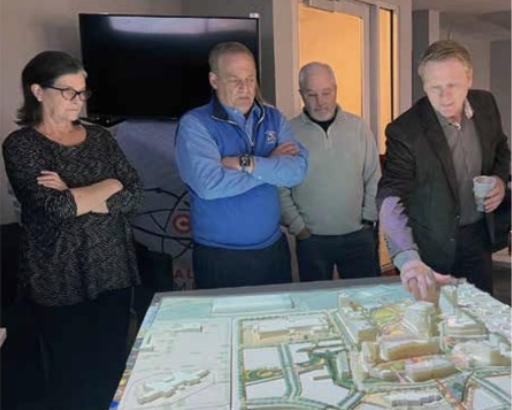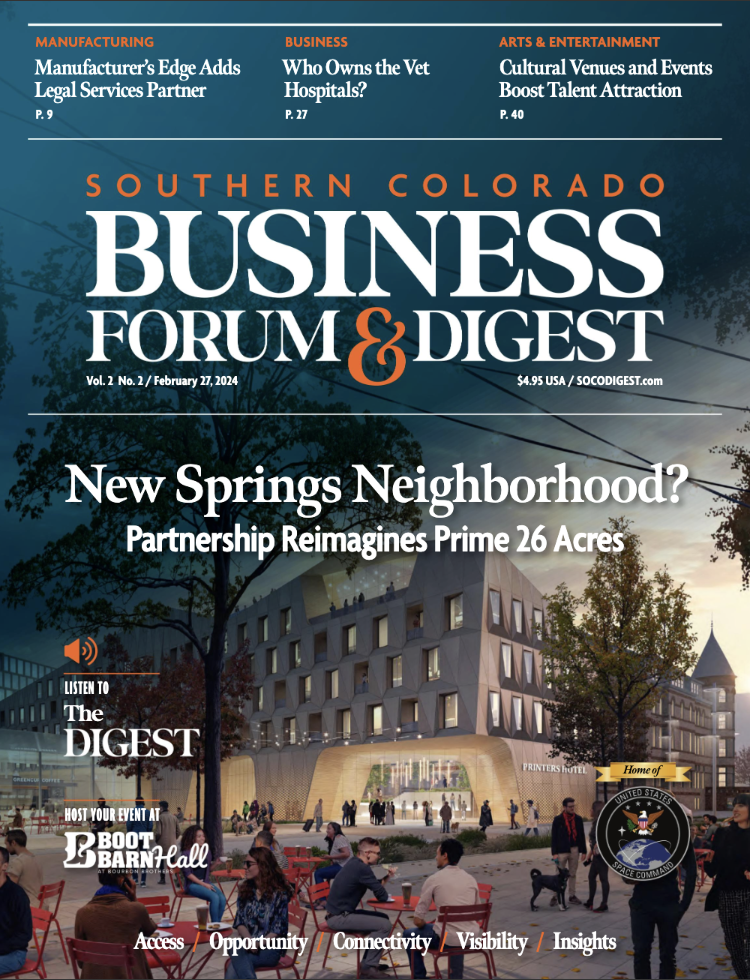
7 minute read
Historic COS Landmark Property-A New Neighborhood Reimagined
from So Colorado Business Forum & Digest Vol. 2, No. 2 | February 27, 2024
by Colorado Media Group :: NORTH, The Digest/CSBJ & So. Colorado Insider!
LEADERS PLAN UNION PRINTERS HOME REDEVELOPMENT
by WAYNE HEILMAN, Senior Writer for The So. Colorado Business Forum & Digest

A partnership of well-known Colorado Springs business leaders is planning a major redevelopment of the historic Union Printers Home complex east of the city’s downtown area, according to plans submitted late last year to city planners.
UPH Partners is seeking approval for a redevelopment plan, rezoning and changes in some building height restrictions on 26.2 acres southeast of Union Boulevard and Pikes Peak Avenue. Plans call for retaining the existing four historic buildings and adding up to a dozen others to create a mixed-use neighborhood called Printers Hill. The requests likely will be considered by the Colorado Springs Planning Commission and City Council this spring.

Susan Loo Pattee, one of seven partners in the project, says the group was formed to save the historic structures from demolition after state officials shut down a nursing home operating in the complex. Other partners include Kevin O’Neil, visionary of the Catalyst Campus (and revitalization of eastern downtown); Jim Johnson, former CEO of GE Johnson Holdings; Tony Bettis, CEO of All-Pro Capital; James Loo, director of the Bloom Foundation; philanthropist Ward Berlin and an undisclosed partner.
“The vision for the entire property is making space for families, kids and outdoors lovers –it will be like a new neighborhood,” Pattee says. “The plan is for a multi-story, mixed commercial and residential development. The castle (the primary building on the property) would become a 200room hotel with an addition that is modern but compatible with the historic building, without mimicking it. We will be adding onto all four (historic) buildings.”
UPH Partners hopes to select a partner by mid-summer that will secure financing and oversee development which Pattee estimates will cost between $500 million and $1 billion and create more than 1.5 million square feet of hotel, office and retail space; townhouses; condominiums and apartments; a food hall and food garden/ greenhouse; parking garages and a possible museum over the next 10-20 years.
Construction is scheduled to begin in mid-to-late 2026, she says.

The partnership also plans to seek approval later this year to become an urban renewal area and create up to six metro districts that would issue tax-exempt bonds to pay for public improvements, including streets, public areas and other infrastructure. The urban renewal designation allows developers to issue bonds repaid by tax revenue that the project generates, called tax-increment financing, which is only available in urban renewal areas.
The project is designed around the “castle” building and will include a large west-facing lawn area in front of the structure and a “quad” or central plaza between the four historic buildings meant to be a public gathering place for dining, shopping, shows and other activities. Other open space could include an underground museum dedicated to the site’s 132-year history of caring for retired members of the International Typographical Union.
“We wanted the plan to feel cohesive and well designed for people, without feeling like an outdoor shopping mall, that has a sense of place compatible with its history,” Pattee says. “Potentially, the project is similar to Union Station (on the west edge of downtown Denver), which has been called Denver’s living room. We call this project the front porch of Colorado Springs, which refers to the front porch of the castle building.”
The project partners hired Boston-based planning firm Sasaki to come up with redevelopment plans for the property. The company has completed dozens of projects worldwide including in the River North (RINO) area of Denver, the Pearl Brewery in San Antonio and the Carlsberg District in Copenhagen. Sasaki also organized trips for partners to Toronto’s Distillery District and Walter Reed Hospital in Virginia to tour other similar historic property redevelopment projects.

The partnership is seeking approval to build structures up to 104 feet tall, above the current 65- and 85-foot height restrictions on the property, mostly along the perimeter of the property to preserve views of the castle from all four directions, Pattee says. The tallest structures, up to 10 stories, are proposed near the lowest point of the 26-acre site, she says.

The partners have met with residents of surrounding neighborhoods several times during the past year — including Knob Hill to the north, Hillside to the southeast and K-land to the south — to seek feedback on the types of redevelopment and reactions to the plans submitted to city planners. Pattee says about 45 people attended a meeting with city planners and partners in January, and reaction was generally favorable.
The partnership was formed after All Pro Capital partners Bettis and Brian Bahr agreed to buy the property for $18.5 million and made a $125,000 down payment on a deal that required them to come up with another $1.25 million within weeks. They began seeking partners and Pattee’s mother, former Colorado Springs City Council member Kathy Loo, sent an email inviting potential investors to a meeting at the castle about a month before the deal was to be completed.

About 70 people attended the meeting in late May 2021, including Denver historic preservationist Dana Crawford and Denver hotel developer Walter Isenberg, both involved in the Union Station redevelopment. The Loo family provided the funds to meet the $1.25 million second down payment, and didn’t really get started raising the remaining $17 million until June 5, or 25 days before the required June 30 scheduled deal closing, Pattee says.
We bought the property to save it; it had been on the market for a while,” Pattee says. She quotes Isenberg during the meeting, saying. “it (the castle) is one of the most incredible gems in the country and if it is going to be torn down, I will stand in front of the bulldozer.
The city of Colorado Springs donated 80 acres in 1889 to entice the union to establish a facility for the care of its aged and infirm union members suffering from tuberculosis and Printers Lung a form of Black Lung disease, according to the development's website. The home opened in 1892 and the property eventually grew to more than 250 acres before all but 26 acres were sold off in the 1980s for development.

UPH Partners
Ward Berlin, Philanthropist
Tony Bettis, President & CEO, All Pro Capital
Jim Johnson, Former Chairman & CEO, GE Johnson Holdings, Inc
James Loo, Director, Bloom Foundation
Kevin O’Neil, President & CEO, The O’Neil Group and Founder, Catalyst Campus
Susan Pattee, Board Chair, Bloom Foundation
Susie Burghart, Philanthropist
Get The Southern Colorado Business Forum & Digest in your inbox!

WANT THE PRINTED EDITION? SIGN UP TODAY!











